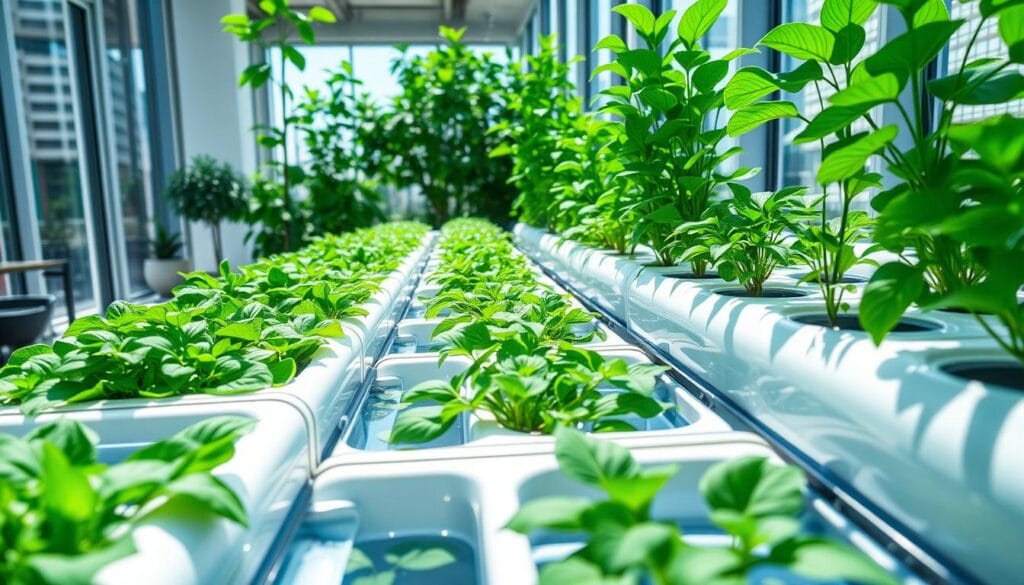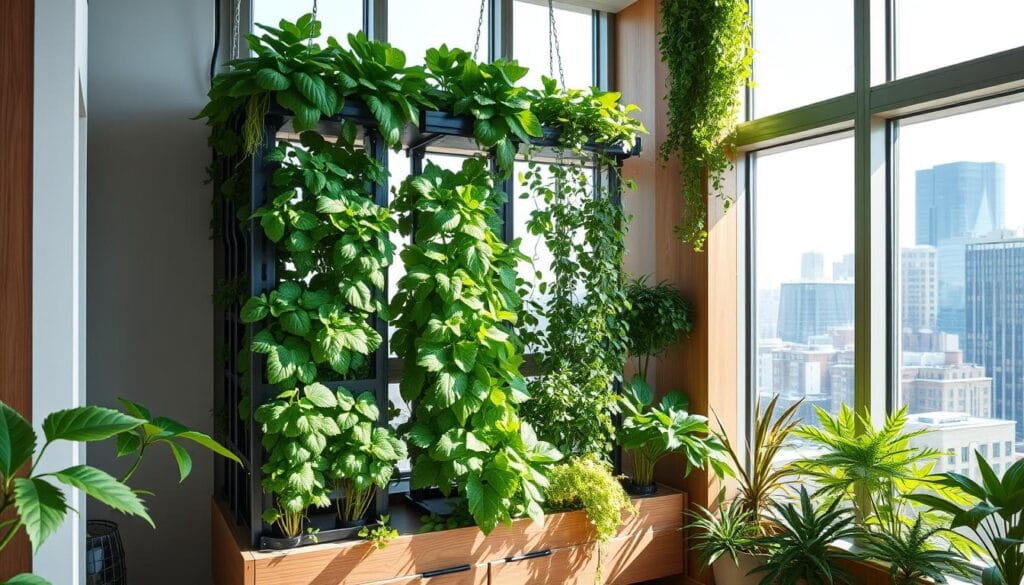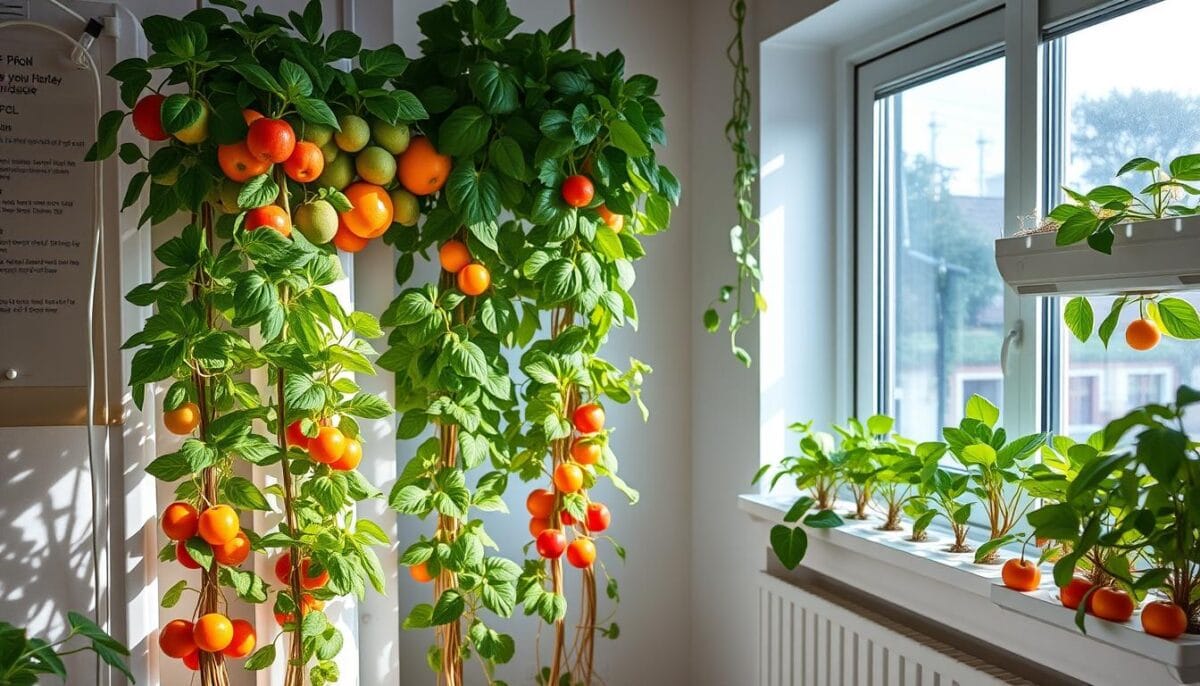If you want to grow fresh, healthy food all year, hydroponic gardening is a great choice. It’s a method that doesn’t use soil. This way, you can grow lots of food in small spaces. It also saves water and energy.
Hydroponic systems give plants the nutrients they need in water. This means no soil is needed. Plants grow fast and stay healthy. You can grow many types of food, like greens, herbs, and even tomatoes, without using harmful chemicals.
Key Takeaways
- Hydroponic gardening enables year-round production of fresh, nutrient-rich crops
- High yields can be achieved in compact indoor spaces
- Hydroponic systems minimize plant diseases and eliminate the need for pesticides
- Water and energy usage is significantly reduced compared to traditional farming
- Consistent growth and quality can be maintained with proper hydroponic system management
What is Hydroponic Gardening?
Hydroponic gardening offers a soil-free method for cultivating plants in a modern way. Plants grow in water full of nutrients, getting what they need directly. This method lets gardeners control the growing space better.
Understanding the Basics of Soilless Cultivation
Hydroponic systems don’t need soil. Instead, they use a special water solution full of nutrients. This lets gardeners control things like pH, temperature, and water flow. It makes a perfect place for plants to grow.
Types of Hydroponic Systems
- Nutrient Film Technique (NFT): A constant flow of nutrient-rich water feeds the plant roots, giving them what they need.
- Ebb and Flow: Plants sit in a tray that gets flooded with nutrient solution and then drained. It’s like the ocean’s tides.
- Deep Water Culture: Plants hang in a container filled with nutrient-rich water. Their roots soak up the nutrients they need.
Each hydroponic system has its own benefits. They’re great for growing different plants, from greens to fruits. Knowing about these systems helps gardeners pick the best one for their indoor garden.
Year-Round Fresh Produce
One of the main perks of indoor gardening with hydroponics is growing fresh produce year-round. This is great for places hit by severe weather like droughts or floods. It’s also good for areas with little access to healthy food, known as food deserts.
Hydroponic systems help grow a steady supply of food, even in cities with little room for gardens. This is especially helpful in urban areas.
Studies show that hydroponic systems use about one-tenth of the water compared to traditional farming. This makes them a smart choice for places with water shortages. They can also produce a lot of food, up to 25+ lbs every 28 days. This means a steady and plenty of harvest all year.
In recent years, cities and groups have started to see the value of indoor gardening. For example, Raleigh, North Carolina, started a community garden in 2021. The University of Wisconsin-Eau Claire has two hydroponic gardens on campus.
The Morgan Hill Unified School District in California created a hydroponic garden for school lunches. The Providence Public Library also has a hydroponic garden as part of its gardening projects.
| Location | Hydroponic Initiative |
|---|---|
| Raleigh, North Carolina | Established a community hydroponics garden in 2021 |
| University of Wisconsin-Eau Claire | Operates two hydroponic gardens on campus |
| Morgan Hill Unified School District, California | Set up a hydroponic garden to address unsatisfactory produce for school lunches |
| Providence Public Library | Invested in a hydroponic garden as part of community gardening initiatives |
These examples show how indoor gardening with hydroponics is becoming more popular. It helps communities enjoy year-round harvests of fresh, healthy food. This is true even in areas with harsh weather and food deserts.
High Yield in Compact Spaces
Hydroponic gardening systems are great for growing a lot in little space. They are perfect for indoor and urban growers. These vertical farming systems can grow up to 25 pounds of food every 28 days. This means you can harvest up to 3,400 plants a year.
The modular and space-saving design of hydroponic systems lets you place them anywhere. You can set them up in apartments, libraries, restaurants, or even commercial facilities.
Growing More with Less Space
Hydroponics is perfect for high-density gardening in cities. Aeroponic systems use much less water than traditional gardening. They save space with their vertical design.
Aquaponics combines hydroponics and fish farming. It supports a lot of plants and fish together. This makes the most of small spaces.
- Hydroponics can use up to 90% less water than traditional gardening.
- Plants in hydroponic systems grow faster and produce more.
- Compact, space-saving hydroponic systems can be set up vertically or in modules.
Using LED lights and controlling the climate in indoor vertical farming boosts crop production. This ensures the right temperature, humidity, and light for plants to grow well. With the right nutrients delivered through soilless media, these modular systems are a reliable way to grow more in less space.
“Hydroponics accommodates a high density of plants in limited spaces, making it perfect for high-density gardening in urban areas.”
Nutrient-Rich and Pesticide-Free
Hydroponic gardening systems are great for growing healthy, chemical-free crops. They don’t use synthetic fertilizers or pesticides like traditional farming does. Instead, they give plants a balanced, nutrient-rich water solution.
This makes the fruits, vegetables, and herbs grown hydroponically very nutritious. They are also free from harmful pesticides. This is because hydroponic farms control the environment, reducing the need for chemicals.
Research shows that hydroponic foods can be as nutritious as or even more nutritious than soil-grown produce. Hydroponic farms also use less water and chemicals. This means you get organic produce that’s both healthy and free from pesticides.
| Attribute | Hydroponic Gardening | Traditional Soil-Based Farming |
|---|---|---|
| Water Usage | 70-80% less water consumption | Higher water usage, often through spraying over the entire plant |
| Pesticide Usage | Reduced need for chemical pesticides due to controlled environments | Increased use of pesticides to protect crops from outdoor pests |
| Nutrient Levels | Similar or higher levels of essential nutrients, vitamins, and minerals | Potential for lower nutrient levels, depending on soil quality and fertilizer use |
| Carbon Footprint | Lower carbon footprint due to reduced transportation and resource usage | Higher carbon footprint, especially for non-local or out-of-season crops |
By choosing hydroponic gardening, you can grow a variety of nutritious crops in a chemical-free way. This is good for your health and helps make your organic produce production more sustainable.
Minimizing Plant Diseases
Hydroponic gardening has a big advantage: it reduces plant disease risk. Since it doesn’t use soil, it avoids many diseases that soil can carry. Also, the controlled environment makes it easier to spot and fix problems early. This means less need for harsh chemicals and less food waste.
In hydroponic and aeroponic farms, diseases like Black Spot, Damping-Off Disease, Fusarium Wilt, Powdery Mildew, Rust, Sooty Mold, and Verticillium Wilt are much less common. Viruses like Mosaic Virus, plum pox virus, tomato yellow leaf curl virus, and potato virus X also happen less often in these setups.
To keep plants healthy in hydroponics, it’s important to keep the system clean and balanced. Good drainage, moisture control, and air flow are key. Using growbags and spacers helps too. These steps make it harder for diseases to spread.
| Disease | Symptoms | Prevention Strategies |
|---|---|---|
| Root Diseases | Leaf yellowing, wilting, slowed growth, discolored roots, unpleasant odors | Proper drainage, moisture control, aeration, use of growbags and spacers |
| Fungal Diseases | Powdery growth, spots, discoloration | Maintain cleanliness, use of organic treatments, and appropriate chemical fungicides in severe cases |
| Viral Diseases | Mottled leaves, stunted growth, distorted shapes | Strict sanitation, early detection, and isolation of affected plants |
Hydroponic gardeners use a controlled environment to fight plant diseases. They watch for problems, act fast, and use treatments as needed. This keeps their crops healthy and disease-free all year.
Resource Conservation
Hydroponic gardening is very efficient, using up to 90% less water conservation than traditional farming. This is because the nutrient-rich water is recirculated and reused. This method minimizes water waste and ensures plants grow well.
Water and Energy Savings
Hydroponic systems also use less energy. They use energy-efficient LED lighting and climate control. This reduces the environmental impact of growing food indoors.
By being energy efficient, hydroponic gardeners use less energy and produce less carbon. This is compared to traditional farming methods.
Keeping the pH level between 5.5 to 6.5 is key for hydroponic plants. It helps them absorb nutrients well. Checking Electrical Conductivity (EC) and Total Dissolved Solids (TDS) is important for nutrient levels. Also, mixing nutrients correctly is crucial to avoid problems in the solution.
| Metric | Optimal Range | Importance |
|---|---|---|
| Dissolved Oxygen (DO) | 5-7 ppm | Promotes root growth and nutrient uptake |
| Oxidation-Reduction Potential (ORP) | 200-350 mV | Indicates healthy water conditions |
| Nutrient Solution Temperature | 18-22°C (65-72°F) | Influences nutrient uptake |
By using sustainable farming practices, hydroponic growers can greatly reduce their environmental impact. They do this by recycling water, using energy-efficient systems, and managing nutrients precisely. This way, they can still grow high-quality, nutrient-rich crops.

“Using hydroponics can save up to 90% more water than standard agricultural “
Consistent Growth and Quality
Indoor hydroponic gardening focuses on consistency. Growers can predict and control crop growth and quality. They manage factors like nutrients, water, light, and plant spacing to ensure a steady supply of fresh produce.
Hydroponic gardening is known for its predictable harvests. Growers optimize conditions to reduce plant growth variations. This leads to a reliable supply of crops, benefiting both growers and consumers.
Hydroponic systems also fight plant diseases and pests well. The controlled indoor environment helps growers prevent threats. This keeps plants healthy and increases the amount of usable, quality produce.
Growers who master hydroponic gardening can provide a steady supply of predictable harvests and quality produce. This consistency is a big advantage over traditional soil-based farming.
Faster Plant Growth
Hydroponic gardening is great for growing plants fast. It uses water full of nutrients that plants can absorb directly. This method also keeps the temperature, humidity, and light just right for plants to grow well and quickly.
Research shows plants in hydroponics grow up to 50% faster than those in soil. This means you can harvest more often and get a bigger yield from the same space.
Hydroponics lets growers control everything plants need for fast growth. Without soil, growers can adjust conditions to get the best results. This leads to amazing productivity.
| Metric | Hydroponic Systems | Soil-based Gardening |
|---|---|---|
| Growth Rate | Up to 50% faster | Traditional pace |
| Harvest Frequency | More frequent | Less frequent |
| Yield | Higher | Lower |
Indoor growers can enjoy fast plant growth and more harvests with hydroponics. They can have fresh, healthy food all year round, right in their homes or city spaces.
” Using hydroponics allows us to grow plants up to 50% faster than conventional soil-based techniques, resulting in more frequent harvests and greater overall yields.”
Hydroponic Gardening for Urban Areas
Urban farming is growing fast, and hydroponic gardening is at the forefront. These systems don’t need soil and are perfect for small city spaces. They can grow in tiny apartments, libraries, and restaurants, making the most of limited areas.
With hydroponics, city folks can grow their own food, even in tiny spaces. This lets them enjoy fresh, healthy produce right at home. It’s a big step forward for urban farming and space-efficient food making.
Overcoming Space Limitations
Hydroponic systems use every inch of space they have. They grow crops vertically and in modules, making the most of small areas. This new way of gardening is changing how cities get fresh, local food.
Studies show hydroponics can grow four times more crops and use 90% less water than traditional farming. This is key in cities, where water and space are often scarce.
| Benefits of Urban Hydroponic Gardening | Key Statistics |
|---|---|
| Maximizing Space Utilization | 4x more crops grown per unit of space |
| Water Conservation | 90% less water usage compared to soil-based farming |
| Resilient Local Food Systems | Reduced carbon footprint from transporting produce |
| Educational Opportunities | Serving as hubs for hands-on learning |
By using compact gardening with hydroponics, cities are changing how they grow food. This leads to a more sustainable, local, and easy-to-access food system.

Health Benefits of Homegrown Produce
Hydroponic gardening opens up a world of nutritional benefits for your health. The nutrient-rich water in these systems makes crops more nutritious than those grown in soil. You get to enjoy fresh, tasty produce full of vitamins, minerals, and antioxidants.
Improved Nutrition and Well-being
Eating a variety of hydroponic-grown, nutrient-dense fruits and veggies can greatly improve your health and gut health. Research shows that eating more plant-based foods can help your gut microbiome thrive. This leads to better digestion, immunity, and wellness.
By growing your own food at home, you avoid harmful pesticides. This makes your produce even more nutritious.
Starting a urban gardening project with hydroponics lets you control your health and connect with nature. Even with a small space, you can grow a lot of fresh, healthy food right where you live.
“Homegrown, hydroponic produce is not only delicious, but it’s also bursting with nutrients that can nourish your body and support your overall well-being.”
Adding hydroponic gardening to your life brings many health benefits. You get to enjoy nutrient-dense, gut health-boosting produce. Plus, you reconnect with nature.
Variety of Crops for Indoor Growing
Hydroponic gardening lets indoor growers grow many types of leafy greens, herbs, fruiting crops, and edible flowers. You can grow everything from crisp lettuces to juicy tomatoes and fragrant herbs. This method makes it easy to grow a variety of fresh produce at home.
Leafy greens like romaine and kale grow well in hydroponics, often better than in soil. Herbs such as basil and parsley also do great, providing fresh flavors all year. Edible flowers like nasturtiums add color and texture to dishes.
Small fruiting crops like cherry tomatoes and strawberries are perfect for indoor hydroponics. They save space and let city dwellers grow their own food, even in small areas.
With the right setup and care, you can grow a variety of tasty and healthy crops indoors. It brings the joy of growing your own food right to your home.
“Hydroponic gardening has introduced a whole new range of possibilities in my life. I’m. I’m able to grow a wider variety of fresh, healthy produce right in my own home, and it’s been a game-changer for my family’s diet.”
Conclusion
Hydroponic gardening brings many benefits to indoor growers. It lets you grow fresh produce all year round. You can also get high yields in small spaces.
This method grows crops without soil, making them rich in nutrients and free from pesticides. It also saves water and energy. Hydroponics are great for growing a wide variety of crops quickly and efficiently.
They are set to become a big part of indoor gardening, especially in cities where space is tight.
This article has shown how hydroponic gardening is versatile and beneficial. It saves money and water, and opens up new farming possibilities in crowded areas. This method is very promising for growing food sustainably.
As hydroponics grow, they will be key in meeting the demand for fresh, healthy food. They will help indoor growers and city communities a lot.
The future of indoor gardening looks bright with hydroponics leading the way. They offer high-quality, nutrient-rich crops in a way that saves space and resources. This is especially important in cities where traditional farming is hard.
As more people see the benefits of hydroponics, it will play a big role in the future of growing food indoors.

